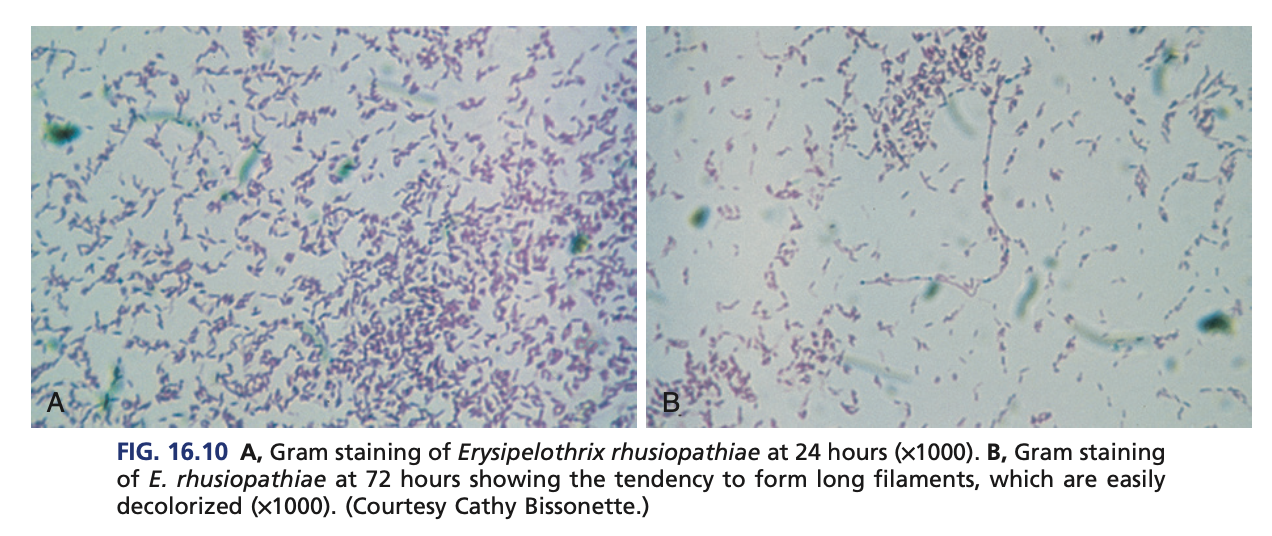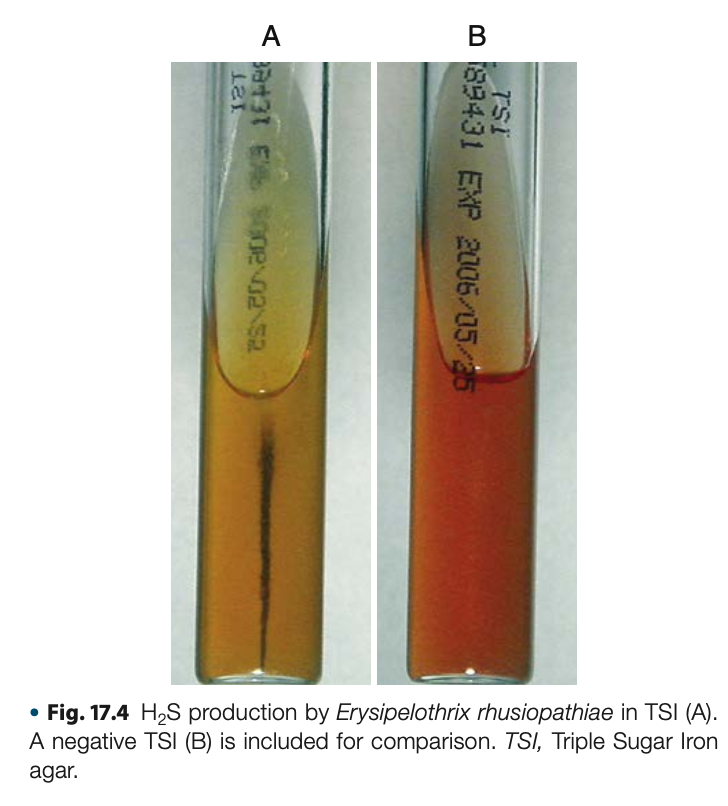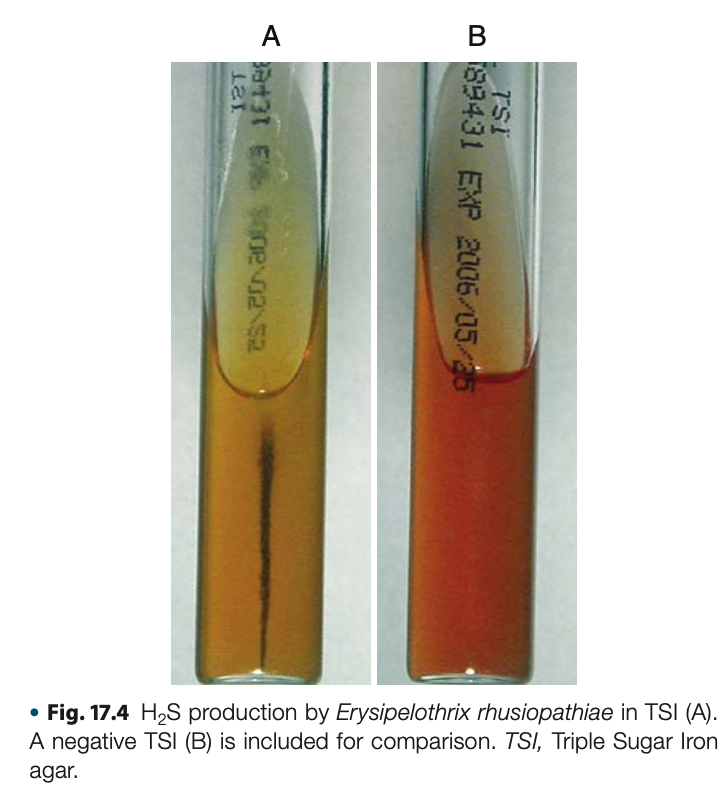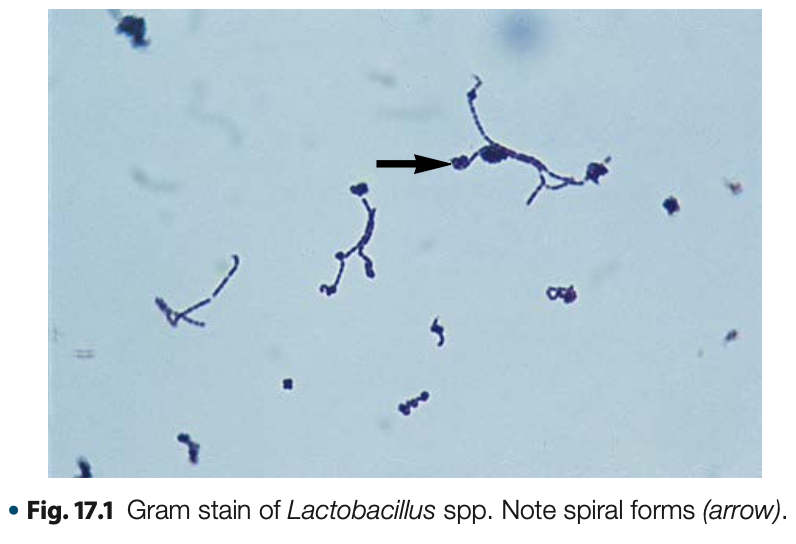Non-Spore Forming
1/168
Earn XP
Description and Tags
Name | Mastery | Learn | Test | Matching | Spaced |
|---|
No study sessions yet.
169 Terms
Erysipelothrix spp.
Listeria spp.
Corynebacterium spp.
ELC
Non-spore forming
Listeria monocytogenes
Soft Cheese
Listeria monocytogenes
Animal Pathogen (primarily)
T
Listeria monocytogenes is FACULTATIVE ANAEROBE (t/f)
T
Listeria monocytogenes is G + rods/coccobacillus (t/f)
F
Listeria monocytogenes is Motile at RT
Listeria monocytogenes is Non-motile at RT
Listeria monocytogenes is Halophilic (10% NaCl)
Listeria monocytogenes is Halophilic (-)
Listeria monocytogenes has an UMBRELLA-LIKE/ INVERTED CHRISTMAS TREE MOTILITY on semi-solid (SIM media)
Listeria monocytogenes has an - on semi-solid (SIM media)
Listeria monocytogenes has a “Tumbling Motility” on Broth at RT (wet mount & hanging drop) – PRESUMPTIVE TEST
Listeria monocytogenes has a - on Broth at RT (wet mount & hanging drop) – PRESUMPTIVE TEST
• Listerolysin O (Hemolytic & Cytotoxic)
Virulence Factor of Listeria monocytogenes
Listerolysin O (Hemolytic & Cytotoxic)
Virulence Factor of Listeria monocytogenes
O2 labile hemolysin
phagocytes
Virulence Factor of Listeria monocytogenes
Listerolysin O (Hemolytic & Cytotoxic) allows the survival of organisms within -.
• Neonatal meningitis
• Sepsis
• Infanseptica granumalotous
• Fetal abortion
• Stillbirth
Diseases Associated with Listeria monocytogenes
MOT: In Utero (Pregnancy)
Food Poisoning
Diseases Associated with Listeria monocytogenes
MOT: Ingestion of Contaminated Food (Coleslaw of Softcheese
SBAP
Cold Enrichment at 4°C
Culture on McBride
Anton Test
+ CAMP Test
Ferments glucose, salicin, & tehalose
+ Hippurate , Bile Esculin OH, & Catalase
– OXIDASE
CHROMagar Listeria
Laboratory Tests for Identification of Listeria monocytogenes
Narrow Band of Beta-hemolysis
Laboratory Tests for Identification of Listeria monocytogenes
SBAP
Cold Enrichment at 4°C
Laboratory Tests for Identification of Listeria monocytogenes
Cold Enrichment at -
Culture on McBride
Laboratory Tests for Identification of Listeria monocytogenes
Selective media for L. monocytogenes
Anton Test
Laboratory Tests for Identification of Listeria monocytogenes
- Ocular virulence test
conjunctival sac of rabbit
Laboratory Tests for Identification of Listeria monocytogenes
Anton Test is an organism inoculated on -
Purulent Conjunctivitis
Laboratory Tests for Identification of Listeria monocytogenes
+result of Anton Test
+ CAMP Test
Laboratory Tests for Identification of Listeria monocytogenes
CAMP Test
Rhodococcus equi / S. aureus
Laboratory Tests for Identification of Listeria monocytogenes
CAMP Test’s Known result
Ferments glucose, salicin, & tehalose
Laboratory Tests for Identification of Listeria monocytogenes
Ferments -
Blue-green colony surrounded by an opaque, white halo
Laboratory Tests for Identification of Listeria monocytogenes
CHROMagar Listeria
– Oxidase
Laboratory Tests for Identification of Listeria monocytogenes
Oxidase
Erysipelothrix rhusiopathiae
Major reservoir is PIG / DOMESTIC SWINE

Erysipelothrix rhusiopathiae is G + rods
Erysipelothrix rhusiopathiae is G + rods (t/f)
T
Erysipelothrix rhusiopathiae is Non-motile (t/f)

H2S Producer
Erysipelothrix rhusiopathiae is known to be a - producer which is naturally producing H2S on BAP even without indicator
• Erysipeloid (Butcher’s / Diamond Cut / Red Disease)
• Septicemia
• Endocarditis
Diseases Associated with Erysipelothrix rhusiopathiae
Erysipeloid (Butcher’s / Diamond Cut / Red Disease)
Diseases Associated with Erysipelothrix rhusiopathiae
A localized skin infection, an occupational hazard for those hazard for those handling meat, poultry, & fish
Erysipeloid (Butcher’s / Diamond Cut / Red Disease)
Diseases Associated with Erysipelothrix rhusiopathiae
Self-limiting infection that resembles streptococcal
Endocarditis
Diseases Associated with Erysipelothrix rhusiopathiae
individuals with valve replacement

• – Catalase, Oxidase, Esculin Hydrolysis, VP, Urease, & Nitrate
• + H2S
• Glucose & lactose Fermenter
• Gelatin Stab
Laboratory Test for Identification of Erysipelothrix rhusiopathiae
Test Tube Brush, Pipe Cleaner, Bottle Brush Pattern of Growth
Laboratory Test for Identification of Erysipelothrix rhusiopathiae
Gelatin Stab uses
Skin biopsies (BEST), tx aspirates & blood
Laboratory Test for Identification of Erysipelothrix rhusiopathiae
Gelatin Stab spx are
+H2s
Laboratory Test for Identification of Erysipelothrix rhusiopathiae
H2S
– Catalase, Oxidase, Esculin Hydrolysis, VP, Urease, & Nitrate
Laboratory Test for Identification of Erysipelothrix rhusiopathiae
Catalase
– Catalase, Oxidase, Esculin Hydrolysis, VP, Urease, & Nitrate
Laboratory Test for Identification of Erysipelothrix rhusiopathiae
Oxidase
– Catalase, Oxidase, Esculin Hydrolysis, VP, Urease, & Nitrate
Laboratory Test for Identification of Erysipelothrix rhusiopathiae
Esculin Hydrolysis
– Catalase, Oxidase, Esculin Hydrolysis, VP, Urease, & Nitrate
Laboratory Test for Identification of Erysipelothrix rhusiopathiae
VP
– Catalase, Oxidase, Esculin Hydrolysis, VP, Urease, & Nitrate
Laboratory Test for Identification of Erysipelothrix rhusiopathiae
Urease
– Catalase, Oxidase, Esculin Hydrolysis, VP, Urease, & Nitrate
Laboratory Test for Identification of Erysipelothrix rhusiopathiae
Nitrate
L. monocytogenes : +
E. rhusiopathiae : ––
Differential test for L. monocytogenes & E. rhusiopathiae
Beta- Hemolytic
L. monocytogenes : +
E. rhusiopathiae : ––
Differential test for L. monocytogenes & E. rhusiopathiae
Growth at 4°C
L. monocytogenes : +
E. rhusiopathiae : ––
Differential test for L. monocytogenes & E. rhusiopathiae
Catalase Test
L. monocytogenes : +
E. rhusiopathiae : ––
Differential test for L. monocytogenes & E. rhusiopathiae
Motility
L. monocytogenes : +
E. rhusiopathiae : ––
Differential test for L. monocytogenes & E. rhusiopathiae
Esculin Hydrolysis
L. monocytogenes : +
E. rhusiopathiae : ––
Differential test for L. monocytogenes & E. rhusiopathiae
VP Test
L. monocytogenes : +
E. rhusiopathiae : ––
Differential test for L. monocytogenes & E. rhusiopathiae
Gluconate
L. monocytogenes : ––
E. rhusiopathiae : +
Differential test for L. monocytogenes & E. rhusiopathiae
H2S on TSI
L. monocytogenes : McBride
E. rhusiopathiae : BAP
Differential test for L. monocytogenes & E. rhusiopathiae
Media

Lactobacillus
Doderlain Bacillus
Lactobacillus
Normal flora of the MOUTH, GIT & VAGINAL CANAL
T
Lactobacillus is an AEROTOLERANT ANAEROBE (t/f)
Lactobacillus
Produced large amount of lactic acid
3.0 – 4.0
Lactobacillus tolerates HIGH ACIDIC ENVIRONMENT (pH of -)
T
Diseases Associated with Lactobacillus
Non-pathogenic & has little clinical significance (t/f)
F
High during pregnancy
Diseases Associated with Lactobacillus
Low during pregnancy (t/f)
Inhibits G. vaginalis, Prevotella, Mobiluncus
Diseases Associated with Lactobacillus
Inhibits -
Promotes C. albicans
Diseases Associated with Lactobacillus
Promotes
Cultivated using Tomato Juice Agar
Laboratory Test for ID of Lactobacillus
Cultivated using
Presence of this bacterium may be noted for PAPS SMEAR
Laboratory Test for ID of Lactobacillus
Presence of this bacterium may be noted for
– Catalase
Laboratory Test for ID of Lactobacillus
Catalase
T
Laboratory Test for ID of Lactobacillus
Non-motile (t/f)
Corynebacterium
Normal flora of the SKIN, & MUCOUS MEMBRANCE
Corynebacterium
- Closely related to Mycobacteria & Nocardia
Corynebacterium is closely related to Mycobacteria & Nocardia
Corynebacterium is closely related to - & -
T
Corynebacterium is club-shaped (t/f)
T
Corynebacterium is known to have Chinese letters morphology (t/f)
T
Corynebacterium has characteristic Palisade (t/f)
T
Corynebacterium has characteristic X & V letters shape (t/f)
Corynebacterium are all GLUCOSE & MALTOSE FERMENTERS (except C. urealyticum & C. pseudodiphtheriticum)
Corynebacterium are all GLUCOSE & MALTOSE FERMENTERS (except -)
Corynebacterium are all GLUCOSE & MALTOSE FERMENTERS (except C. urealyticum & C. pseudodiphtheriticum)
Corynebacterium are all - & - fermenters (except C. urealyticum & C. pseudodiphtheriticum)
The cell walls of Corynebacterium contain MESODIAMINOPIMELIC ACID (m-DAP) as the diamino acid & short-chain mycolic acid but NON-ACID FAST
The cell walls of Corynebacterium contain -) as the diamino acid & short-chain mycolic acid but NON-ACID FAST
F
The cell walls of Corynebacterium contain MESODIAMINOPIMELIC ACID (m-DAP) as the diamino acid & short-chain mycolic acid but NON-ACID FAST
The cell walls of Corynebacterium contain MESODIAMINOPIMELIC ACID (m-DAP) as the diamino acid & short-chain mycolic acid but ACID FAST (t/f)
Diptheroid
– Normal flora
raised, translucent, gray colonies
Laboratory Test for ID of Corynebacterium
BAP
• BAP- raised, translucent, gray colonies
• + Catalase & Oxidase
• Babes-Ernst Metachromatic Granules
• NON-MOTILE, NO SPORE & CAPSULE
• Pleomorphic gram (+) rods
• Cysteine–Tellurite Blood Agar
Laboratory Test for ID of Corynebacterium
+ Catalase & Oxidase
Laboratory Test for ID of Corynebacterium
Catalase & Oxidase
F
NON-MOTILE, NO SPORE & CAPSULE
Laboratory Test for ID of Corynebacterium
• NON-MOTILE, WITH SPORE & CAPSULE
(t/f)
Pleomorphic gram (+) rods
Laboratory Test for ID of Corynebacterium
Pleomorphic gram (-) rods
Cysteine–Tellurite Blood Agar
Laboratory Test for ID of Corynebacterium
uses what Blood agar
Babes-Ernst Metachromatic Granules
Laboratory Test for ID of Corynebacterium
has what granules
• Large
• Flat
• Dark
• Gray
• “Daisy Head”
Laboratory Test for ID of Corynebacterium
colonies of Gravis
Medium
Laboratory Test for ID of Corynebacterium
colonies of Mitis
• Small
• Black
• “Bleach-like Odor”
Laboratory Test for ID of Corynebacterium
colonies of Intermedius
Non-hemolytic
Laboratory Test for ID of Corynebacterium
hemolysis of Gravis
Non-hemolytic
Laboratory Test for ID of Corynebacterium
hemolysis of Mitis
• Beta-hemolytic
• “Fried-egg Appearance”
Laboratory Test for ID of Corynebacterium
hemolysis of Intermedius
Listeria : +
Corynebacterium : ––
Differential Test for ID of Listeria & Corynebacterium
Motility
Listeria : +
Corynebacterium : ––
Differential Test for ID of Listeria & Corynebacterium
Esculin HOH
Listeria : +
Corynebacterium : ––
Differential Test for ID of Listeria & Corynebacterium
Salicin
Listeria : +
Corynebacterium : ––
Differential Test for ID of Listeria & Corynebacterium
CAMP
Corynebacterium diphtheriae
Inhabits human nasopharynx but only in carrier state
Corynebacterium diphtheriae is NOT part of the normal flora of respiratory tract
Corynebacterium diphtheriae is part of the normal flora of respiratory tract (t/f)
T
Corynebacterium diphtheriae is NONMOTILE (t/f)
T
Corynebacterium diphtheriae is Highly phleomorphic (t/f)
F
Corynebacterium diphtheriae is very resistant to drying & remains viable in the environment for weeks
Corynebacterium diphtheriae is very resistant to drying & remains non viable in the environment for weeks (t/f)